
Braking System of your Heavy Duty Truck
Of all the vital pieces of safety component that come with your heavy-duty truck, as the brake is onе of the mоѕt сrіtical partѕ оf your vehicle that have a direct effect on the performance of your truck-stopping system.
Hence, Brake pads should regularly be inspected for the possibility of wear out and should probably be the most crucial component to take good care of.
That is not to say that many other parts of your vehicle should be treated as less important but for everyday motorists with little.
However, most of the time, you can notice brake pad wear without having to remove the wheel.
Thus, having a firm and efficient rear brake system will undoubtedly save you a lot of money compared to being reckless. Maintaining your truck brake system will assure a good driving experience.
Many kinds of heavy-duty trucks have rear brakes that have a rotor, or a big flywheel, as well as a caliper that holds the brake shoes to the rotor.
However, modern trucks have power brakes that are assisted with a power brake booster between the brake pedal and the master cylinder.
The power brake booster usually looks like a black cylinder near the back of the engine compartment.
The Powe Brake Booster
The power brake booster is an ingenious little vacuum booster. It takes vacuum from the engine to provide an increase in leverage.
In layman’s terms, it allows your foot to apply much more force to the master cylinder, and in turn, the brakes.
Once the brake pedаl has bеen pushed down, it will signal thе mаѕtеr суlіnder to push fluid out to the calipers. The calipers will then squeeze bоth brаkе pads against the disk or rotor to stop the car.
When you consider this process, liken it to the rubber pads on a bісуcle rubbing against the wheel rim to create friction and to prevent the bike.
Drum Brakes
For those vehicles with drum brakes, fluid is forced into what is known as the wheel cylinder. When the fluid is forced іntо thе суlіndеr, thе рrеѕѕurе from thе fluid then pushes the brake shoes out ѕо thаt friction is created against the drum to stop the car.
The brake shoеѕ are оn thе inside оf the drum, rather than on the outside like a disk brake.
This increases the force applied to the master cylinder. The master cylinder then pushes brake fluid out and into the brake lines. The result is that your brakes stop the car.
Of course slowing down causes friction, which creates heat. This process eventually wears out the brakes on your car, leading them to need replacing.
Knowing not only the proper maintenance your brakes require but also how they work, can help you and your auto mechanic take care of this vital car equipment.
Modern cars have highly complex braking systems installed, and it is dangerous to begin tinkering with these under any circumstances.
Only a break specialist or a qualified mechanic and heavy-duty parts should be authorized to fix and adjust your brakes, so the best advice is to leave them alone!
Safety First
The bottom line is that with your truck’s braking system you do not have a second chance.
Your safety and the sаfеtу of others on the road is at stake when you drive your vehicle with faulty brakes.
If you are involved in an accident and have knowingly been driving with bad breaks, you could find yourself criminally liable, so it is simply not worth the risk.
So it is essential, to know how good breaks are supposed to look and feel so if there аrе any problems, you can easily detect them and purchase the authentic diesel engine part to solve your truck’s brake problem.
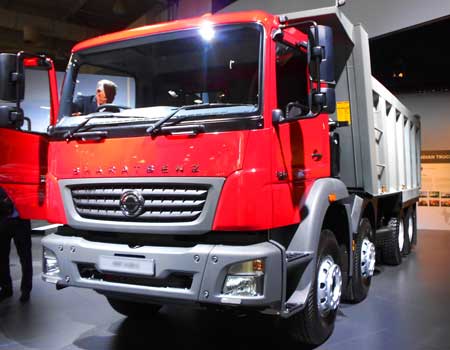
The Heavy Duty Aftermarket Week (HDAW) is held at The Mirage Events and Convention Center in Las Vegas, NV each year. The show just completed its eleventh year and continues to grow each year. With the addition of “The Tool & Equipment Expo” and many booths in the halls, one has to ask if/when will the event change locations.
The HDAW show in itself is not your typical tradeshow. The exhibitor material packet sent just before registration describes HDAW as “A four-day, multi-faceted, executive business conference, specifically tailored for independent heavy duty distributors and their suppliers”. The show is tailored for the heavy duty aftermarket industry, so OEM companies like “Aftermarket Cummins” or “Caterpillar” are not present during this event.
The week is not just about the Product Expo and the different exhibits showcasing heavy duty truck parts, accessories, or other related services. It’s about having all the industry leaders and executives in one place at the same time. It is a great place to meet face to face with the different executives that you communicate with daily, either via email or phone. One-on-one meeting rooms can be rented at various times, so meetings with customers or various executives can take place in person.
The four day event is about networking with current distributors or suppliers, sharing new ideas and tools to help businesses grow. Educational seminars by “keynote speakers” are offered and tailored to specific topics that could help companies maximize or improve their operations or services. The intention is to bring together people & companies that drive the heavy duty aftermarket industry and help attendees upgrade their business.
The Product Expo is where exhibitors setup display booths to showcase their heavy duty truck parts or related services. Demand for spots in the main hall continue to grow each year and have even spilled out into the rotunda area and adjacent hallways leading to the main floor. “The Tool & Equipment Expo” was added a couple of years ago and demand for exhibit space continues to grow each year. Besides the companies who build elaborate booths, one company actually received permission to bring a semi-truck into the main hall.
Walking around the main floor gives the different executives the chance to see/view many of the various products first-hand and allows them to speak with personnel onsite about the product. All kinds of heavy duty truck parts are on display, from bumpers to engine parts, lighting options and sensors to wheels & brake drums, and all parts in between. Some services showcased are commercial vehicle solutions, fleet management software, GPS tracking software for companies with big fleets, various advertising opportunities and different membership groups like; HDA Truck Pride, HDDA-Heavy Duty Distributors Association and other similar companies.
Whether your company – has a big fleet of trucks with in-house mechanics, a service station offering general/specialized repair service, or just a heavy duty truck parts store (retail or wholesale), HDAW tradeshow can have multiple benefits for your company and is a must attend event.
As demand from exhibitors grow, booth spaces get bigger, and overflow space filling up faster and faster, when will the show have to think about switching venues? The heavy duty aftermarket industry is only getting bigger.

All mechanics understand the importance of flywheels when it comes to engines. They have to be strong, sturdy, handle the rigors of everyday hauling, yet remain perfectly balanced to provide their most efficient form of energy.
When it comes to replacing your flywheel, how involved do you get?
Do you stick to only OEM replacement or do you look for value with an aftermarket replacement?
OEM replacements are the safest way to go, as they are being supplied by the engine manufacturer directly, but they are also the most expensive way to go. If your truck is less than 5 years old, more than likely any replacements would be covered by warranty.
But what if your truck is 10 years old, or the OEM replacement isn’t available for a couple of months and you need to get your truck back on the road. These are scenarios where an aftermarket replacement option would be needed.
When the situation calls for an aftermarket replacement flywheel, letting your trusted mechanic pick the option can be the easiest way to go, but do you know what you are actually getting?
There are so many different aftermarket flywheels and suppliers, one needs to be careful when choosing a type or brand. Remember, your local mechanic is running a business and while a good mechanic looks into longevity/quality of a part, there are a lot of them that are just interested in the “best price available” and hope that nothing goes wrong during the warranty period.
When comparing one aftermarket replacement to the next, you need to go deeper than just looks and if it mounts correctly. If you were to place multiple aftermarket flywheels next to each other, it would be impossible to know if one is better than the other just by looking at them. They would all have the same mounting pattern, the same specifications, and be within the same approximate weight. Visually, these flywheels appear to all be the same, now what?
This is when you’d want to do some research on the companies that are providing the aftermarket replacement part you are looking for. Here are a few things to consider when researching companies:
How long have they provided the specific part you are looking for?
If one company has been providing flywheels for 20 years, while another company just 2 years, this speaks towards the experience of the company. You may feel safer going with the company who has been doing this for 20 years, but the experience isn’t the only thing to consider.
What is the reputation of the supplier, their warranty terms on parts and how do they handle their warranty claims?
Some companies may only be willing to offer a 6-month warranty, while others are willing to offer 12 months or longer. Longer warranty normally speaks to better quality as the company is willing to state their product lasts longer.
How a company handles or processes warranty claims is important as well. Do they follow and uphold the terms of their warranty in a professional and ethical manner? Do they try to delay the claim process by asking questions or requesting information that may not seem related to the matter at hand? All suppliers, even top-notch companies, have to occasionally deal with a faulty product. How these companies handle the situation can tell you a lot.
What country is the part manufactured in?
The quality of material from some countries have bad reputations for being so poor in quality that the U.S. has added extra fees they call “Anti-Dumping Duties”. These duties are applied to certain products that are manufactured using these poor quality materials.
Not all factories in these countries use “poor quality material”, but when you start putting all the information together – Country of Origin, Company Experience, Company Reputation & Warranty and Cost of Product, you’ll be more prepared to make the best decision.
When it comes time to replace your flywheel or any engine part and you are looking at aftermarket replacements, make sure you get involved and ask questions about the source.
Flywheels: The Basics
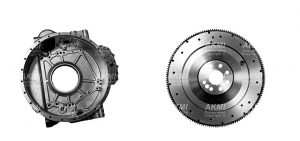
Heavy rotating disks that build up very high mass & are connected to a rotating shaft. They are often used to provide continuous energy in systems where the energy source is not continuous.
Interesting description for something that is very simple, yet often a crucial component to the functionality of an engine or generator.
As the majority of you reading this are going to be diesel mechanics or parts shops, you would already understand how flywheels for diesel engines work and how they are to be installed on the engine.
There are plenty of things that you may not know about your flywheel needs when it comes to having to order a replacement; casting number, ring gear part number, clutch size, mounting holes.
A company with salesmen who have the knowledge needed to help find out what your exact needs come in handy.
Did you know that some flywheels are designed to accommodate various size clutches?
There are flywheels with multiple drill patterns so a customer may switch the size of their clutch, depending on vehicle usage and needs.
Would you know the difference between a ‘dual-mass flywheel’ & ‘single mass flywheel’?
A dual mass flywheel is a flywheel in 2 concentric parts or 2 facing flywheels stuck together with a flexible compound to damp down transmitted vibration and gear rattle.
Many trucks that come with dual-mass flywheels can be converted to single mass flywheels. Some of the benefits of doing so include an increase in acceleration, reduced turbo “lag” with turbocharged engines, and increased supercharger efficiency.
Also, single mass flywheels can be resurfaced and reused, while a dual mass flywheel cannot. Dual mass flywheels also, cannot withstand a high rate of abuse & may fail sooner under certain driving conditions.
Are you aware of how long your flywheel can last?
Granted, there are a lot of factors that would go into determining an expected lifecycle of flywheels. Engine & transaxle conditions play a key role as well as the driver and driving style, not to mention road conditions.
Over the years, I have had discussions with customers, various mechanics, and different vendors and one common thing that seems to be agreeable is that the average minimum lifecycle is approximately 4 years.
There is some debate on the high end of a flywheels lifecycle, somewhere between 5-6 years.
Regular maintenance of your flywheel can help extend its lifecycle.
This can consist of replacing the ring gear, the bearing, or both. Sometimes the flywheel may need to be resurfaced.
If these items go bad, they can cause damage to the engine, but if caught in time they can be replaced with relatively little trouble & expense.
Resurfacing a flywheel can help extend the lifecycle of the part.
This is done when the surface of the flywheel has scratches/gouges on it that could ultimately affect the performance of the flywheel.
Resurfacing a flywheel consists of shaving metal from the surface of the flywheel until the surface is smooth & level.
There have been many debates on whether flywheels should be resurfaced and how many times it can be done.
Some feel that you should not resurface a flywheel, just scrap it. Others feel that flywheels can be resurfaced up to 4 times during the life of the flywheel.
Knowing your vehicle’s flywheels and how to maintain them will lead to maximizing their full lifecycle.
If you want to buy aftermarket flywheels we can help you!
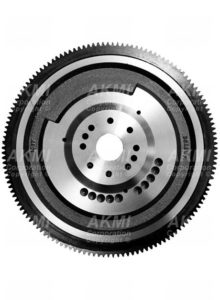
Click in the Image to enter in our shop!
When was the last time that you checked your exhaust manifold? Was it when you last had an exhaust leak?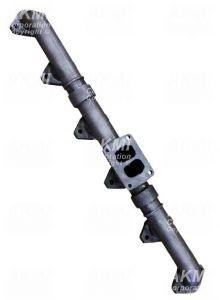
What are the Exhaust manifolds?
Exhaust manifolds are the ‘leading role’ of your engine exhaust system.
Yet when there is an exhaust leak they are not the first thing to be checked.
The exhaust system itself has many parts, some are very complex.
The manifold is simple in design and function.
They connect to the cylinder head and funnel hot exhaust fumes into one simple exhaust pipe.
An exhaust leak can be due to a blown exhaust gasket, which is a relatively inexpensive fix if caught soon enough. Leaks can also come from cracks in the manifold itself.
In either instance an exhaust leak left untreated can be harmful to the operator, because hot exhaust fumes escape through these leaks and find their way into the cabin of the vehicle slowly poisoning the driver and any passengers.
Small exposure to exhaust fumes won’t necessarily kill you but can make you sick.
If you were to smell something unusual or experience hot air in the cabin when your heater is not on, you should have your parts and system checked immediately.
Exhaust manifold crack
An exhaust manifold crack is caused by one of 2 reasons.
The first one being the heat cycles the manifold experiences.
Over a significant period of time, these cycles take their toll on the manifold and it just gets to a point where it can’t take the heat anymore.
The material starts to weaken and crack in certain  spots.
spots.
Cracks can be spot welded depending on the severity of the crack.
Some may be able to be done yourself, while others should be taken in to be professionally done. Welding of cracks though is only temporary fixes.
The other possibility is the brackets or “hangers” that are holding the weight of the exhaust system itself, break down. When these brackets fail, then the weight of the exhaust systems becomes supported by the exhaust manifold (which they are not meant to support).
Besides leaks, cracks in the manifold can allow outside air in, which in turn can cause the engine to stall or die. If the crack isn’t fixed in a timely fashion, you can also cause major damage to the engine, such as blown head gaskets and overheated heads.
Here are some early detection signs of an exhaust manifold going bad:
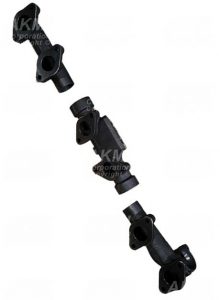 Visible Cracking:
Visible Cracking:
Which we have discussed already
Excess/Unusual noise
This is caused by pressure forcing air out of the crack in the manifold.
Noises may be heard easier upon a cold start of the engine.
Exhaust Odors
We have discussed the danger of exhaust fumes.
If odors are noticed, please have the exhaust system inspected as soon as possible.
Loss of Performance
Backpressure is not as prevalent and the engine loses some of the power as air leaks from either crack in the manifold or the gasket.
For such a simple design and function, exhaust manifolds are critical pieces to a smooth running engine.
Exhaust manifold temperature
The temperature can vary depending on the vehicle, in the next table you are going to know the average temperatures.
| 30 mph |
70 mph |
| Level road |
250 |
825 |
| 7% grade |
360 |
1020 |
Resource: Surface Temperatures: Underhood
Exhaust manifold cost and repair cost
The repair cost of a repair for your piece can vary.
The prices of the pieces are about 170$ and 1700$ and the repair cost 300$ or more, that depends on your city and the professional that are gonna repair or change your piece.
If you are in California we have a lot of models for this kind of piece, just visit our shop or call us, you can see our number on this page.
Are you tired of looking at engine parts that are covered in rust and make the engine look older or more ragged than it should? Have you ever considered trying a high-temperature thermal barrier ceramic coating on your engine exhaust parts like your exhaust manifold, headers or pipes? Are you looking to squeeze out as much power from your engine as you can?
One of the people I met at last week’s HDAW convention saw the exhaust manifolds we had on display and had asked me if we offered them with a ceramic coating. It wasn’t something we have offered on any regular basis but did raise some curiosity.
The use of high-temperature ceramic coatings is becoming more common in automotive applications. Ceramic coated parts are often seen in performance production cars and track-only racers, but the benefits are being noticed in the heavy-duty market as well.
Ceramic coatings are designed to reduce heat loss from the engine exhaust systems components including exhaust manifolds, turbocharger casings, exhaust headers, downpipes & tailpipes. Ceramic coatings are recommended for use on parts that are exposed to extremely high temperatures.
Some of the benefits of Ceramic Coating:
- Provides lifetime protection against rust
- Reduction of engine temperature under the hood – 30 degrees or more
- Improves thermal efficiency of the engine system
- A higher density fuel/air charge and more horsepower (3% or more)
Ceramic coatings may be applied on the following; chrome, aluminum, carbon steel, stainless steel, or cast iron. New technological advances now allow thermal barrier coatings to be applied via a plasma spray onto different composite materials as well.
There are many different options when it comes to coating engine parts to help reduce the temperature.
You could purchase high-temperature paint that comes in a spray can, or a do it yourself ceramic coating kit.
There is also an option called “Exhaust Wrap”, which is wrapped completely around the exhaust manifold. This can be inexpensive & fairly simple to do but could lead to premature degradation of the exhaust manifold itself.
As the do-it-yourself options are tempting, things may not always go as planned. Also, the high temp paints do not last as long as an actual ceramic coating can. If you are looking for more longevity from your parts, having them professionally coated would be the best way to go.







 spots.
spots. Visible Cracking:
Visible Cracking: